What Is An Altered Book?
Simply put, an altered book is an art object that has been created from an existing, printed book. The book is altered through whatever means and media the artist chooses. This generally means using the book’s pages as a canvas on which to apply paint, collage or rubber stamping. It could also mean cutting into the book to create a more sculptural piece.
Approaches to book altering are as varied as the artists who undertake them. A textile artist or quilter might choose to use fabric to alter their books. A rubber stamper might opt to stamp and use inks and sprays. A painter could use a book as a canvas for several works in acrylic, watercolor, or oils. Each artist brings their own skills acquired in other creative pursuits, and applies them to the same general surface: a printed book.
Some altered book artists choose to work within a certain theme throughout the pages of a book, while others see each page as a work that stands on its own. Some artists choose to work collaboratively, in exchanges or round robins, where books are passed around a group of artists, each adding her own work to whichever book she has at the moment.
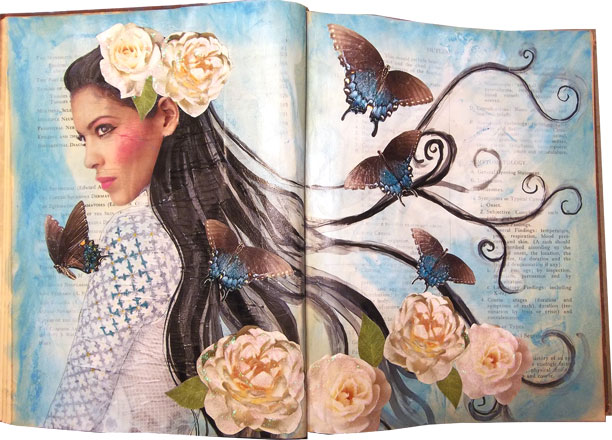
But I Would Never Deface a Book!
Many altered book artists have experienced the hand-wringing and wailing that comes from people who believe that books are sacred objects, and should never be defaced. If you’re one of those people, let me put your mind at ease:
- Most altered book artists work in old books. Not museum-quality old. Back of the used book store, marked down to nothing, nobody has any use for them any more old. We work in books that, if not purchased for art, will be shredded for pulp.
- Many artists check the books they buy against vintage book listings, to ensure they are not about to cut into a book that still has value. In general, if you bought a book for a dollar, Googled it when you got home, and discovered a copy of it was causing a bidding war on eBay, you probably wouldn’t cut into it. Neither would I, nor would any other reasonable person.
- Some artists have a personal list of books they absolutely would not use for altering, no matter how old or inexpensive it might be. Some (but not all) would pass on working in a Bible, Quran, or other holy books. Some might prefer not to work in a book of another artist’s images, as in a tabletop art book.
Altered book artists respect books in a way that is second only to librarians. Never fear: we are not defacing books that anyone wants or needs. We are resurrecting old, unloved books, and turning them into art!
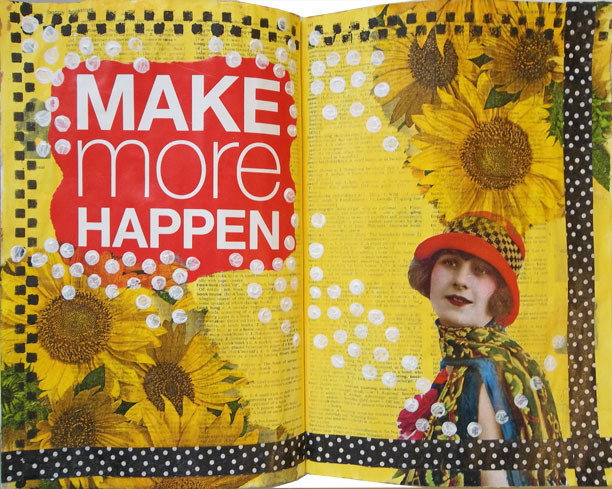
How To Choose a Book For Altering
If you’re looking for a book to alter page by page, you’ll want to consider a few things. You should probably choose a book that’s constructed with a sewn spine, filled with soft paper, in a size you can live with.
This video will show you how to choose a book for altering:
Things to look for:
- Size. I like to work big, so I hunt for large books. You might like to work smaller. This is a personal preference, and one that you will develop as you work. If you’re choosing your first book, don’t feel you have to know what the perfect size for you might be. you’ll learn that as you go.
- Paper quality. I like pages that feel like they have a lot of cotton in them: soft to the touche, and sturdy. That usually means choosing an older book. Avoid books with glossy pages.
- A sewn spine. Check the headband to be sure it’s soft and loose, with scalloped ridges where groups of pages (signatures) are attached. Look for the beginning of a signature, and check it at the spine for stitching.
Books to avoid:
- Paperbacks. In general, paperback books aren’t sturdy enough to withstand altering.
- Glued bindings. Pages that are glued into the spine rather than stitched will pull out easily.
Preparing Books To Alter
If you’re going to alter a book in a way that adds even a little bulk, you may want to prepare it first, by removing some pages.
This video will show you how to prepare a book for altering, without compromising the structure or the spine:
Now What?
Once you have your book prepared for altering, use whatever creative skills you have to fill it! The one and only rule about altering a book is that their are no rules. Whatever you feel like doing to your book is fine. Draw in it. Doodle in it. Paint in it. Light it on fire and throw it in the bath tub. (I really did this. Twice. Both times, for books concerning fire.)
A Year of Altered Books
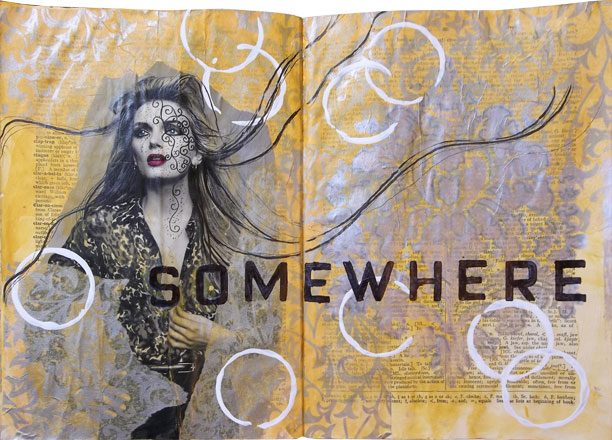
I teach a year-long class called A Year of Altered Books. Many of the pages shown in this article , including those in the gallery above, are samples from the class.
All You Need is Love
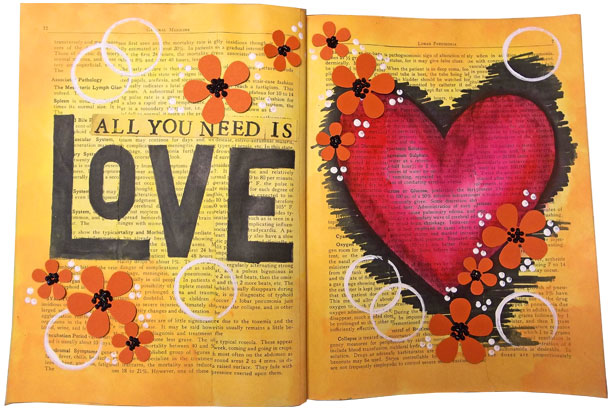
Many altered book artists keep practice books, where they work on their techniques, try new materials, and just generally play, without worrying about the outcome. I did the All You Need is Love pages, above, in my practice book, and shot the fast-motion video of how they were created, below, as I worked.
Find Some Like-Minded Book Lovers
A great way to learn about altered books is to find a big bunch of people who are also making them. Here are two groups in which I’ve been active for many years:
Altered Books on Yahoo! Groups, started in 1999, contains the Internet’s largest repository of altered book information. You’ll find endless tutorials in the Files section.
Altered Books on Facebook was started by members of the Yahoo! altered books group, so we could have a presence on Facebook. It’s a great place to see photos of finished altered books, and to ask a quick question.

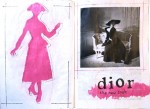
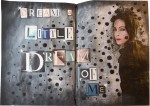
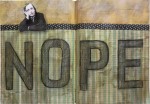
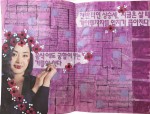
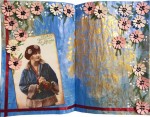
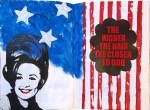
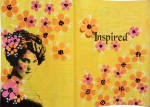
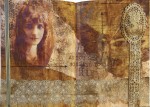
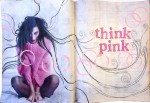
Found a perfect book but previous owner highlighted quite a few pages. Can I work around the highlighting or will that be a hinderence.
Only you can answer that question, Joan. Can you work around the highlighting? If you think you can, the book will be fine. If you look at the highlighting as an obstacle, you should probably choose another book.
Remove pages that have a lot of highlighting?!
Glaze the whole page to match the highlighting, then work from there.
I think you probably could. It would look great
Lisa, thank you for sharing your knowledge and experience! I’ve been approaching an altered book project without knowing that “altered books” was a thing. Your posts on altered books will give me a running start and some needed confidence. Off to read more of your posts!
I loved your breakdown of what to look for in a book to alter…so helpful!!! Thanks!!!
Thank you, this is very informative and I’m excited for my next book!
Thanks for providing this article! I am a librarian (and artist) and teach a monthly art class. My upcoming August one is about altered book journals. Although I’ve made many, I didn’t really know how to present on it! This was a great help thank you thank you thank you!
Great information. Finding articles, videos, samples are fresh and far between. It was exciting to find you, thanks much.
You have a wonderful resource here! I will definitely be reading more of your site!
Hi Lisa! Thanks for the tutorial! I have a question regarding your heart/love page. Why did you put the extra strip down the middle before you started on the two pages? Just wondering what the purpose of that serves. Thank you!
There’s a void between the two columns of text on dictionary pages. Those strips fill that void.
These tips are extremely helpful. I love books and I love collage/mixed media art and want to get back into it. I was just curious did you seal the “All you need is love” pages, and what did you use? I saw you recommended Dorland’s wax for sealing pages in another article. Does that work on these types of papers as well?
I pretty much seal all my pages with a light coat of matte medium, and then a coat of Dorland’s over, to keep the pages from sticking together.